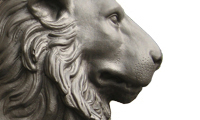Canopy fragment of Ain Soltane

A Christogram in the apex of an arch identifies the stone block discovered in the Algerian Ain Soltane (near Sétif) at the end of 19th century as a Christian piece of art. But we have a similar problem to that arising with the objects from Sillégue. It is not clear which place had a vaulted superstructure. A baptismal font (piscina)? An altar? A door? Or the upper part of an aedicula? When the arch was made there was no indication of where it was to be placed and we cannot exclude any of the aforementioned possibilities. The relief decoration appears as the only reference point for closer investigation. The Christogram is flanked by tendrils of vine, which is not a specific Christian motif but one that is well-known from ancient art. However, we have to begin with a Christian meaning because of the Christogram. Since the vine was understood as a symbol of Christ by Christian interpreters, any starting place must relate to a christological meaning. An ascription to a Christian building is therefore quite probable, whereas an ascription to a specific part of a building is not.




